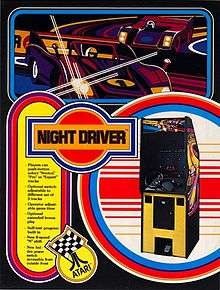Night Driver (arcade game)
 Arcade flyer | |
| Developer(s) | Micronetics Inc. |
|---|---|
| Publisher(s) | Atari, Inc. |
| Designer(s) | Ted Michon (Micronetics), Dave Shepperd s/w; Ron Milner, Steve Mayer, Terry Fowler h/w |
| Platform(s) | Arcade, Atari 2600, Commodore 64, MSX |
| Release date(s) |
Arcade Atari 2600
|
| Genre(s) | Racing |
| Mode(s) | Single-player |
| Cabinet | Upright and cockpit |
| Arcade system | CPU: M6502 (@ 1.008 MHz), Sound Chips : Discrete (@ 1.008 MHz) |
| Display | 23 inch Raster resolution 256×256 (Horizontal) Palette Colors 2 |
Night Driver is an arcade game developed by Ted Michon[2][3] and licensed by Atari Inc for release in the United States in October, 1976. Originally licensed by Atari from German firm Micronetics whom Ted Michon had sold the game to and had released the game in 1977 as Night Racer,[4] Ted's version was in turn inspired by the earlier discrete coin-op Nürburgring 1.[5][6] It is considered one of the earliest first-person racing video games, and is commonly believed to be one of the first published games to display real-time first-person graphics.
Gameplay
The player controls a car which must be driven along a road at nighttime without crashing into the sides of the road as indicated by road side reflectors. The game is controlled with a single pedal for gas, a wheel for steering and a four-selection lever for gear shifting. The coin-operated game had a choice of three difficulties, novice, pro, and expert, from which the player could choose at game start. The turns were sharper and more frequent on the more difficult tracks. As play progresses, the road gets narrower and more winding.
The game length could be set by the owner to 50, 75, 100, or 125 seconds.[7] After 300 points, a player is awarded bonus time equal to game time, but the score wraps around back to zero at 1000 points, so it is possible to reach 300 points more than once.[8] Due to the additional points received for more difficult play, playing on the expert setting is actually the easiest to achieve extra time once a player has mastered the game.[8]
Due to the limitations of arcade technology at the time, the car the player is driving is not actually drawn on-screen. Instead, the car is a printed plastic insert that is laid under the screen. Also, the fact that the car is driving at night made it easier for the programmers to draw the environment with limited graphics at the time, as most things (street, buildings, ...) didn't need to be drawn because they were supposedly completely dark.[9]
There were two versions of the cabinet manufactured, an upright and a cockpit. The upright version had a blacklight installed inside the cabinet which illuminated the bezel.[7][10]
Ports
After the success of the arcade, Rob Fulop ported the game over to Atari's home system at the time, the Atari 2600, the Apple II and the Commodore 64.
The Atari 2600 version uses the paddles to control the vehicle. The player pushes the fire button to accelerate the car forward, and uses the paddle to steer the vehicle, although it was not possible to shift gears in this version. Every frame the program toggles drawing either the vehicle and road hazards or the road posts that defined the track. This causes the game graphics to flicker continually. The game offers eight different levels. Some of the levels are timed, and the player tries to score as much as they can in 90 seconds, and others are not timed. The consumer port also added features not present in the coin-operated version, such as additional vehicles the player must avoid as well as showing houses and trees along the sides of the road.
The Apple version uses the paddle to steer. The numeric buttons 1 to 4 change the gear and thus the speed.
The Commodore 64 version is called Night Drive.[11]
The Atari 2600 version of Night Driver was made available on Microsoft's Game Room service for its Xbox 360 console and for Windows-based PCs in May 2010.
See also
References
- ↑ "Production Numbers" (PDF). Atari. 1999. Retrieved 19 March 2012.
- ↑ http://www.digitpress.com/library/interviews/interview_david_rolfe.html
- ↑ "Good Deal Games - Classic Videogame Games INTERVIEW - David Rolfe".
- ↑ www.arcadeflyers.com, Daniel Hower, Eric Jacobson,. "The Arcade Flyer Archive - Video Game Flyers: Night Racer, Micronetics".
- ↑ "Nuerburg Ring Game". Retrieved 7 November 2012.
- ↑ "Game Review". Retrieved 7 November 2012.
- 1 2 "Owner's Manual". Retrieved 7 November 2012.
- 1 2 "Night Driver Museum Entry". Retrieved 7 November 2012.
- ↑ "Racing Game Pioneers". Retrieved 7 November 2012.
- ↑ "Arcade Museum". Retrieved 7 November 2012.
- ↑ "Night Drive on Commodore". Retrieved 7 November 2012.
External links
- Night Driver at AtariGuide
- Night Driver at the Killer List of Videogames
- Night Driver at Arcade-History.com
- Night Driver at Atari Age
- Night Driver at MobyGames
- Marketing flyer for Midway's Midnight Racer
- Karoshi Corporation
- Night Driver for Atari XL/XE with VBXE board
- Night Driver for standard Atari XL/XE
- Night Driver at GameFAQs
- "Night Driver Manual"